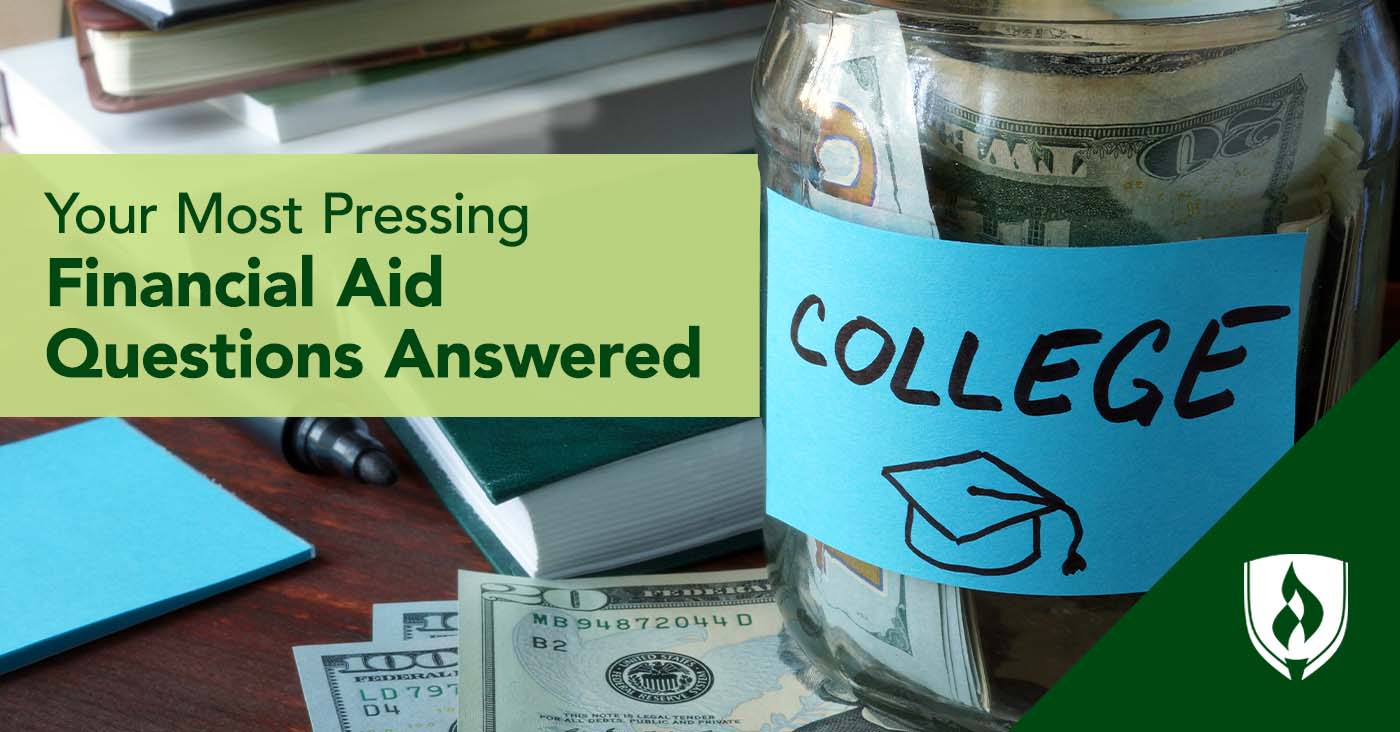
You’re motivated to make a better life for yourself and your family while pursuing the career of your dreams. But let’s face it – college is a big investment, and for those who qualify, financial aid will most likely play a significant role in their decision.
If you’re ready to move on to bigger and better things but still have financial aid questions hanging over your head, don’t worry! The Rasmussen University financial aid team has provided some of the most common financial aid questions students have and answered them. Read on to learn more.
Common financial aid questions and answers for new students
1. What is FAFSA®?
If you’ve dipped your toes into exploring financial aid options, you’ve most likely seen the term “FAFSA” referred to left and right. So what is it, exactly? FAFSA stands for Free Application for Federal Student Aid, and it’s your first step in the financial aid process.
In order to qualify for federal aid (e.g., grants and loans), students must complete the FAFSA form to determine their eligibility. This is a critically important step for students looking to make their time in college more affordable.
2. When should I fill out my FAFSA?
Like with many things in life, the sooner you can get it done, the better. Before completing the FAFSA form, you’ll first need to create an FSA ID. This ID will be used as a digital legal signature for your FAFSA form. It’s important to get this taken care of ahead of time as it can sometimes take up to 3 days before you can use it—and no one wants to get stuck waiting in limbo for something this important.
Once that’s ready, there are a few more pieces of information you’ll want to have ready ahead of time:
- Social Security number
- Driver’s license number
- Federal income tax return
- Records of untaxed income
- Records of your assets
- The list of schools you’re interested in attending
With that in mind, the earliest date you can complete the FAFSA form each year is October 1st. Keep in mind, certain types of financial aid are “first come, first serve” so it only benefits you to get your FAFSA completed as soon as possible.
3. What types of financial aid are there?
There are a few different types of financial aid. Often a student’s financial aid package will include a combination of both federal grants and federal loans. The federal grants are not to be paid back, but federal loans are.
In addition to federal grants and subsidized loans, financial aid can also come in the form of work-study jobs, scholarships and state aid. Scholarships typically do not require repayment and are typically awarded by nonprofit and private organizations to students who meet certain criteria (for example, maintaining a high GPA while studying a specific subject).
Federal and state work-study programs provide funding that allows qualified students to work part time as they pursue their education. While not a universal requirement, these programs encourage the work done by students to be either community service work or related to their field of study.
4. Are there requirements to meet for financial aid eligibility?
In order to receive financial aid, there are eligibility requirements to be met. First and foremost, you need to meet the basic eligibility criteria outlined by the U.S. Department of Education. This means you must:1
- Demonstrate financial need
- Be a U.S. citizen or eligible noncitizen
- Have a valid Social Security number (some exceptions apply)
- Be enrolled or accepted for enrollment as a regular student in an eligible program
- Be enrolled at least half-time in order to be eligible for Federal Direct Loan funds
- Maintain satisfactory academic progress
- Sign the certification statement on the FAFSA form
- Be a high school graduate, have a GED or equivalent
Whether that list of criteria seems simple to comply with or you’re already seeing a potential issue, take the time to review the federal student aid eligibility requirements page for a more detailed breakdown.
Another important piece to keep in mind is that students need to meet Satisfactory Academic Progress (SAP) standards in order to maintain their financial aid eligibility. This includes maintaining a positive GPA and an acceptable pace of credit completion. For further details, see the “Standards of Satisfactory Academic Progress” section of the Rasmussen University course catalog.
5. Where can I find scholarship opportunities?
Scholarships can come from a wide variety of sources, ranging from federal programs to small local organizations. While having a lot of potential options to apply to is certainly not a bad thing, it does take some digging to find what’s available.
Fortunately, there are some solid options for starting your search. The Department of Labor’s Scholarship Finder tool is an excellent resource for exploring potential options. Sallie Mae’s Scholarship Search tool and Fastweb are also reputable scholarship search engines that will help match you to eligible opportunities free of charge.
Additionally, your state’s education department may be able to assist with finding state and local options. Another tried-and-true tactic is to reach out to local civic and community organizations to see if there are opportunities. Don’t forget to explore professional organizations in your preferred field, as well.
Looking for additional resources? Start with the “Other Ways to Save” section of the Rasmussen University Tuition and Aid page.
6. What can Rasmussen University staff help me with?
At Rasmussen University, our teams of Financial Aid, Admissions and Academic advisors can assist you with the following financial aid topics:
- Guiding you through the financial aid process and answering questions about the FAFSA form
- Offering personalized explanations of federal financial aid eligibility and payment options
- Providing guidance regarding financial aid options and counseling to manage affordability
- Providing financial aid award notification and informing students of any adjustments to financial aid awards or eligibility requirements
7. Are there any overlooked options for financial aid?
One often overlooked option is tuition reimbursement through your employer. Some employers have reimbursement policies for their employees who are continuing their education. Students also sometimes overlook state grants. While some of these options may take a little additional work and coordinating up front, they’re worth keeping on your radar.
8. What is one thing every student needs to know about financial aid?
Students sometimes do not realize that their federal loans are a part of the financial aid package, which typically includes both grants and loans. Another lesser-known fact: As you advance through your courses, you become eligible for more loan money.
9. Where else can I find answers to financial aid questions?
There’s a lot to cover when it comes to financial aid, and you may have questions that expand beyond the list above. Fortunately, you’re not at the end of the line. Rasmussen University students can access the RUBOT financial aid chatbot directly from the student portal for helpful information and answers day and night. Additionally, Rasmussen University offers a wealth of high-quality informative videos addressing common questions, topics and terms to know.
Of course, some questions and situations may need a more personal touch to navigate. The financial services team at Rasmussen University is also available to help walk you through anything that may come up.
“I’ve always enjoyed talking to students and being able to help them better understand financial aid,” says Rasmussen University director of financial aid advising and outreach Jessica Crotty. “It can be a confusing process to complete the FAFSA, receive an award notification and figure out what it all means.”
The bottom line
Navigating the financial aid process can be overwhelming – there’s no doubt about it! But if you’re just beginning your financial aid journey, know that it isn’t difficult to apply. You can determine your eligibility for a range of financial assistance simply by filling out the FAFSA form.
Of course, financial aid is just one piece of the puzzle. If you’re gearing up for college, you’ll also want to have your academic habits in order. So why not learn from students like you? Our article “Academic Success: 7 Simple Habits of the Best Students” will help set you on the right track.
1“Federal Student Aid: Basic Eligibility Criteria” U.S. Department of Education. [accessed November, 2021] https://studentaid.gov/understand-aid/eligibility/requirements
EDITOR’S NOTE: This article was originally published in March 2014. It has since been updated to include information relevant to 2021.
FAFSA is a registered trademark of the U.S. Department of Education.




